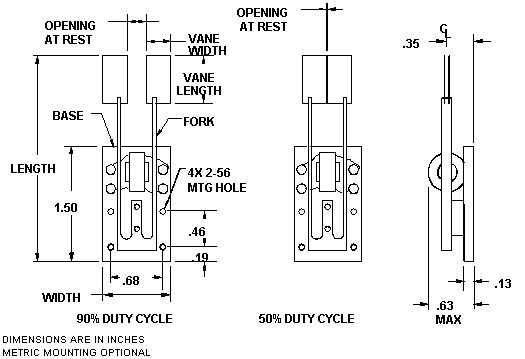Optical choppers are widely used in various scientific applications, usually in combination with lock-in amplifiers. Among optical choppers, tuning fork choppers stand out as the most dependable. With an impressive lifespan, they excel even in extreme environments such as high temperatures, ultra-high vacuums, and cryogenic conditions. Their versatility extends to chopping light, plasma, X-rays, and laser beams.
Unlike rotating choppers, a tuning fork chopper operates at one fixed frequency. The chopper moves at the natural resonant frequency established by the effective mass of the moving assembly and the spring constant of the tines. Vanes, attached to moving tines, open and close an apperature to modulate a light beam. Balanced operation and high "Q" insure excellent frequency stability, low electrical drive power and low reaction forces. High flexural stiffness provides good resistance to shock and vibration.
The chopping frequency is chosen from a specified range, with practical apertures of up to 15mm for frequencies under 100 Hz. If the beam size is a limiting factor, beam focusing is recommended.
The following should serve as guide lines only:| FREQUENCY(Hz) | LENGTH(Inches) | WIDTH | VANE | OPENING AT REST(Inches) |
||
| SINGLE COIL(Inches) | DOUBLE or TRIPLE COIL(Inches) |
LENGTH(Inches) | WIDTH(Inches) | |||
| 10-50 | 2.81 | 0.88 | 1.00 | 0.63 | 0.37 | 0.20 |
| 60-200 | 2.69 | 0.88 | 1.00 | 0.63 | 0.31 | 0.20 |
| 200-400 | 2.56 | 0.88 | 1.00 | 0.50 | 0.31 | 0.20-0.10 |
| 400-600 | 2.40-2.00 | 0.88 | 1.00 | 0.40 | 0.24 | 0.10-0.06 |
| 600-800 | 2.00 | 0.88 | 1.00 | 0.40 | 0.24 | 0.06-0.04 |
| 800-1000 | 2.00 | 0.88 | 1.00 | 0.40 | 0.23 | 0.04-0.03 |

| FREQUENCY | 50% DUTY CYCLE | 90% DUTY CYCLE | ||
| FULL APERTURE | FULL APERTURE | |||
| (Hz) | (mm) | (Inches) | (mm) | (Inches) |
| 10-150 | 5.1 | 0.20 | 10.2 | 0.40 |
| 200 | 4.0 | 0.16 | 8.1 | 0.32 |
| 250 | 3.8 | 0.15 | 7.6 | 0.30 |
| 300 | 3.1 | 0.12 | 6.1 | 0.24 |
| 400 | 2.4 | 0.10 | 4.8 | 0.19 |
| 450 | 2.0 | 0.08 | 4.0 | 0.16 |
| 500 | 1.8 | 0.07 | 3.6 | 0.14 |
| 600 | 1.5 | 0.06 | 3.0 | 0.12 |
| 700 | 1.2 | 0.05 | 2.0 | 0.09 |
| 800 | 1.0 | 0.04 | 2.0 | 0.08 |
| 900 | 0.8 | 0.03 | 1.6 | 0.07 |
| 1000 | 0.6 | 0.03 | 1.2 | 0.05 |
Standard options include dark or bright vanes. Dark vanes are generally light aborbent and brigth vanes are generally light reflective. Special vane configurations, such as mirrors, lenses, gratings, and custom shapes, are available upon consultation. Additionally, a range of drive electronics with diverse packaging, regulation, and power supply options are offered. Special pricing is extended to OEM applications. The standard operating temperature range is -40°C to +65°C.
TYPE [CH-10]; DUTY CYCLE [%]; VANE [B=bright or D=dark]; FREQUENCY [Hz]
Example: PART NO. CH10-90D-825. This part number specifies the model CH-10 chopper, with 90% duty cycle, dark vanes and an 825 Hz operating frequency.
Special vane configurations, modulating waveforms and shapes are available on special order. Consult factory. Drive electronics with different packages, regulation, and reference signal and power supply options are available. Special pricing for OEM applications.